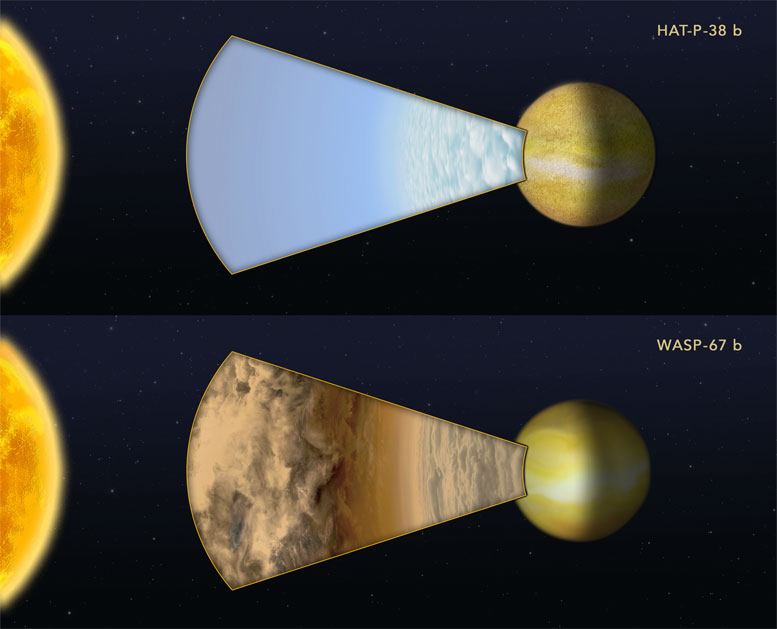
This diagram compares Hubble Space Telescope observations of two “hot Jupiter”-class planets orbiting very closely to different sun-like stars. Astronomers measured how light from each parent star is filtered through each planet’s atmosphere. HAT-P-38 b did have a water signature indicated by the absorption-feature peak in the spectrum. This is interpreted as indicating the upper atmosphere is free of clouds or hazes. WASP-67 b, has a flat spectrum that lacks any water-absorption feature, suggesting most of the planet’s atmosphere is masked by high-altitude clouds. Credit: Artwork: NASA, ESA, and Z. Levy (STScI)
Using the Hubble Space Telescope astronomers compare two seemingly similar “hot Jupiter” exoplanets, finding that WASP-67 b and HAT-P-38 b have very different atmospheres.
Is it a case of nature versus nurture when it comes to two “cousin” exoplanets? In a unique experiment, scientists used NASA’s Hubble Space Telescope to study two “hot Jupiter” exoplanets. Because these planets are virtually the same size and temperature, and orbit around nearly identical stars at the same distance, the team hypothesized that their atmospheres should be alike. What they found surprised them.
Lead researcher Giovanni Bruno of the Space Telescope Science Institute in Baltimore, Maryland, explained, “What we’re seeing in looking at the two atmospheres is that they’re not the same. One planet—WASP-67 b—is cloudier than the other—HAT-P-38 b. We don’t see what we’re expecting, and we need to understand why we find this difference.”
The team used Hubble’s Wide Field Camera 3 to look at the planets’ spectral fingerprints, which measure chemical composition. “The effect that clouds have on the spectral signature of water allows us to measure the amount of clouds in the atmosphere,” Bruno said. “More clouds mean that the water feature is reduced.” The teams found that for WASP-67 b there are more clouds at the altitudes probed by these measurements.
“This tells us that there had to be something in their past that is changing the way these planets look,” said Bruno.
Today the planets whirl around their yellow dwarf stars once every 4.5 Earth days, tightly orbiting their stars closer than Mercury orbits our sun. But in the past, the planets probably migrated inward toward the star from the locations where they formed.
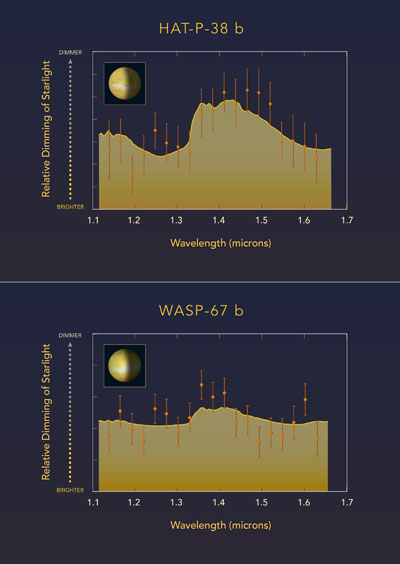
This diagram compares Hubble Space Telescope observations of two “hot Jupiter”-class planets orbiting very closely to different sun-like stars. Astronomers measured how light from each parent star is filtered through each planet’s atmosphere. HAT-P-38 b did have a water signature indicated by the absorption-feature peak in the spectrum. This is interpreted as indicating the upper atmosphere is free of clouds or hazes. WASP-67 b, has a flat spectrum that lacks any water-absorption feature, suggesting most of the planet’s atmosphere is masked by high-altitude clouds. Credit: Artwork: NASA, ESA, and Z. Levy (STScI)
Perhaps one planet formed differently than the other, under a different set of circumstances. “You can say it’s nature versus nurture,” explains co-investigator Kevin Stevenson. “Right now, they appear to have the same physical properties. So, if their measured composition is defined by their current state, then it should be the same for both planets. But that’s not the case. Instead, it looks like their formation histories could be playing an important role.”
The clouds on these hot, Jupiter-like gas giants are nothing like those on Earth. Instead, they are probably alkali clouds, composed of molecules such as sodium sulfide and potassium chloride. The average temperature on each planet is more than 1,300 degrees Fahrenheit.
The exoplanets are tidally locked, with the same side always facing the parent star. This means they have a very hot day-side and a cooler night-side. Instead of sporting multiple cloud bands like Jupiter does, each probably has just one broad equatorial band that slowly moves the heat around from the day-side to the night-side.
The team is just beginning to learn what factors are important in making some exoplanets cloudy and some clear. To better understand what the planets’ pasts may have been, scientists will need future observations with Hubble and the soon-to-be-launched James Webb Space Telescope.
The team’s results will be presented on June 8 at the 230th meeting of the American Astronomical Society in Austin, Texas.
TITLE: Clouds in exoplanet atmospheres: comparison of two apparently similar giant planets
ABSTRACT BODY: Abstract (2,250 Maximum Characters): We present a study aimed at a better understanding of the physics of clouds, which have been shown prevalent in hot Jupiter atmospheres. We compare and contrast the atmospheric spectra of WASP-67 b and HAT-P-38 b, part of our HST/WFC3 and Spitzer observation programs of exoplanets in transmission spectroscopy and secondary eclipses. These two planets lie in a very similar region of the equilibrium temperature-surface gravity parameter space and their compared analysis is therefore particularly significant.
With the help of retrieval exercises on the molecules characterizing the 1.1-1.7 microns WFC3 spectra, we discuss which conclusions can be drawn about the atmospheric processes of these two giant planets.

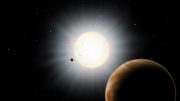
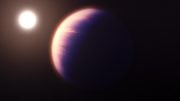
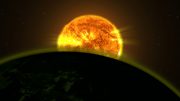

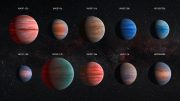
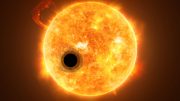
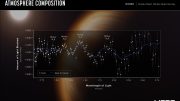

Be the first to comment on "Hubble Comparison of Two “Hot Jupiter” Exoplanets"